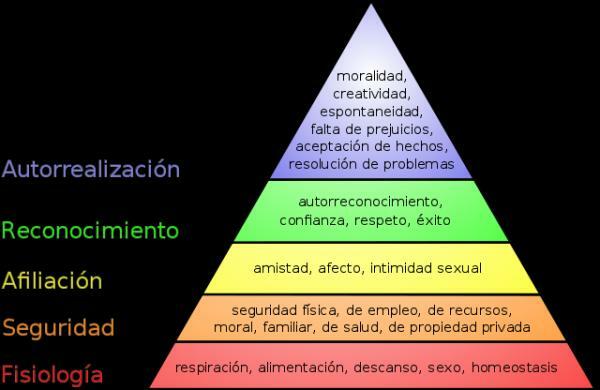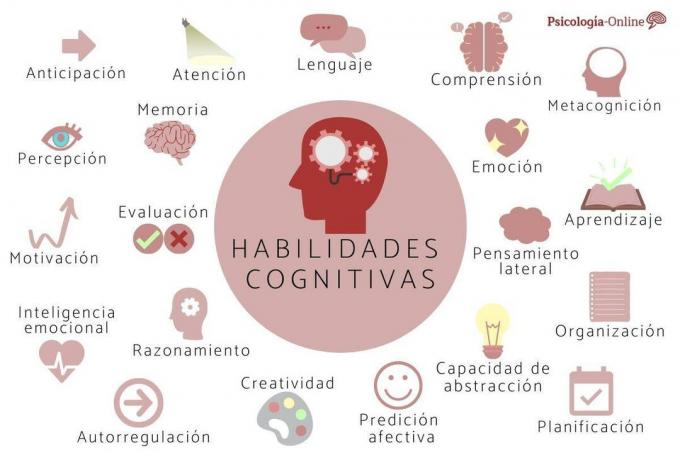
Depression is a mood disorder that can get complicated and last for a long period of time if not treated properly. In PsicologíaOnline we present below a clinical case example of depression, from the presentation of the practical case to the possible hypotheses and techniques for addressing the problem, among other aspects.
Index
- Analysis of the demand and elaboration of the first hypothesis
- Individual hypotheses from the Integrative Perspective
- Couple Hypothesis
- Family Hypothesis
- Integrative therapeutic approach
- Phases of approach and therapy to treat depression
- Techniques
- Example in the case of Luisa
- Approach from the systemic perspective
- Systemic therapeutic approach for couples and families
- Phases
- Techniques in the session
- Techniques at home
Analysis of the demand and elaboration of the first hypothesis.
Luisa makes a lawsuit in which she explains that she carries long-term depression (8 years), with suicidal tendencies. During the first interview, other latent reasons are detected, such as:
The first hypothesis in this case she is a Mood Disorder, according to DSM-IV, it may be an F.32x Major Depressive Disorder or an F34.1 Dysthymic Disorder. similar, although they differ by the intensity of the manifestations, the persistence (chronic or episodic) and the onset (phasic or insidious). Among the diagnostic criteria, we recognize in Luisa: a chronically depressed mood that is present most of the day, lasting more than 2 years, low self-esteem, increased self-criticism, feelings of guilt or sadness regarding the past, subjective feelings of excessive anger, ideation of suicide or death, although not act. Given the data we have, we would have open questions to be able to make an accurate diagnosis, so a psychometric evaluation could be carried out, which will help us to obtain the same.
Individual hypotheses from the Integrative Perspective.
Psychodynamic Model
The psychodynamic hypothesis would tell us about Luisa's speech in which she gives herself the recurring theme of guilt and self-punishment, in the form of exaggerated self-criticism: “... guilt for never having pleased her... I have always been rebellious... my criteria is not valid... as if I was useless... ". These would constitute the symptom, who is expressing the conflict: the need for resolve the unresolved grief with her mother and her friend, two different but unsolved losses. The guilt that Luisa feels is a real guilt insofar as a desire of and for hers superego, requiring self-punishment. In the depressive, ambivalence arises in front of the object, in which in principle what is loved is desired and later it is preferred to destroy the loved object rather than lose it. Her defense is her guilty attitude and her self-punishment. The relationship with her mother is very important, since the first relationships mark the present ones. In Psychoanalysis, depression does not have a clinical entity as such, but we would be talking about melancholia, which constitutes a deeply painful state of mind, in which interest in the outside world ceases, loss of the ability to love, inhibition of functions, self-depreciation and loss of self-esteem, resulting in self-reproaches and self-accusations, which induce the subject, as is our case, to the delirious expectation of punishment and suicide. In melancholy, there is a loss of object, which is called real or imaginary affront or disappointment, the result of which is not slow detachment and displacement towards another object, but rather Libido withdrawn from the object goes to the self through the identification of the self with the resigned object, that is why the subject's affliction is so hard, the loss of the object would be equivalent to the loss of the self. And the person identified with the object has to reproach himself for the loss of it, and hence the self-reproach in the depressive, directed at himself.
Behavioral Model
The behavioral hypothesis tells us that the absence of reinforcements, deficiency of skills social and negative events that occurred in the person's life is what will cause the depression. Luisa has lived several negative events as they are: death of her death leaving an unresolved matter pending, loss of a friend, disappointment at having trusted her friend and having led the family to a tough financial situation, what would be the antecedents that precede her behavior, explaining her depressive behavior. Depression is due to a lack of reinforcement that makes the sufferer not act; not finding reinforcements in their family, social environment, etc. and consequently depression perpetuates itself. Louise does not find positive reinforcement in his family: "My son doesn't pay attention to me... they laugh with complicity and I can't stand it... he seems stupid because nothing changes... my husband trusts her more than me ...". The symptom will be Luisa's learned maladaptive behavior of passivity and depression., which will affect your relationship both as a couple and as a family. Her responsiveness is limited by depression itself.
Cognitive Model
The cognitive hypothesis would be based on the idea in the existence that the person has of judgments negative, experiences of failure, learned helplessness, lack of control, attributions negative... Depression will be the result of inadequate, rigid and absolute schemes that predispose you to perceive the situation in terms of threats and dangers. It is due to a cognitive distortion, in which the depressive distorts reality, seeing himself in a negative way in the cognitive triad: the self, the world and the future. Luisa has a meaning structure full of irrational thoughts (Ellis, 1962) and cognitive errors (Beck, 1967), which is what is causing her depression. These meanings are what she gives to her everyday experiences, so being irrational they cause her great emotional suffering. We recognize irrational thoughts such as that external events cause much of your unhappiness or my past is still important and continues to determine my feelings and behaviors in the present: "... everything has overwhelmed me... I never knew how to show it ..." as well as cognitive errors: take outhasty conclusions –Think reading-: "... others think I'm crazy ..." personalization: "... I am to blame for never having pleased her ..." overgeneralization "... my criteria have no value... I say everything little objectively ...".
Experiential Model
The experiential hypothesis would say that Luisa's depression is due to a frustrated form of existence. She exhibits dysfunctional behavior because she is not in the here and now; She is not in what she makes of her, does not commit to the experience and does not feel enriching for her. Luisa is blocked, she has pending to resolve conflicts from the past (grief and farewell to her mother, overcoming the disappointment caused by her affair with her friend) and that makes her she blocks herself, limits herself, does not really know what she feels: as soon as she says that "... my family of origin like my children and my husband are a treasure ..." like that "... my husband is a coward and a useless... she seems stupid because she doesn't change anything... ”, mixed feelings, she has difficulty expressing her emotions using them in an inappropriate way in the process of activating her: "... there is anger... rage, importence... but it wouldn't be fair for her to express them because they all behave very well to me... ”(defense mechanismà introjection).

Couple Hypothesis.
Psychodynamic Model
The psychodynamic hypothesis would say that the choice of the partner is studied from the theory of Relationshipof object "The subject's mode of relationship with her world, the result of a certain personality, apprehension more or less imaginative of objects and predominant types of defense ”(Laplanche and Pontalis, 1979). This concept is related to the Oedipus complex and with the identification, so the choice is not a "crush" but depends on the previous fantasies (conscious and unconscious) and the childhood history of each person. For this reason, a pathology of couple relationships can be outlined that experience their union as an exchange between “the child and his mother”, a union that causes an alienating relationship. In Luisa's case, it would seem that she is reliving in her relationship the relationship that she had with her mother, which, as she comments at the beginning of the interview, was pathological. We should inquire more about the personality of her mother, to find out if the choice she made of her husband was due to similarity or opposition. Many conflicts and problems that she currently has with her husband would be caused, according to this approach, by having produced a fading of idealization by contact with reality, the transformation of the idealized object into a hated and persecutory object.
Behavioral Model
The behavioral hypothesis would say that in the relationship that Luisa maintains with her husband there are a series of daily conflicts that make it possible to maintain the predominance of negative over positive interactions. The interaction they maintain is carried out through maladaptive behaviors, which have caused communication to gradually become impoverished. One of the most important aspects of the couple is mutual support and Luisa feels that her husband does not give it to her: “... I have told my husband not to do it, to tell me what to do, to explain things to me, but he seems stupid why not changes... ". One of the first behaviors to develop isAttachment (Bowbly, 1969), understood as the search for protection against external threats and Luisa does not find this in her husband: “... my marriage is not a marriage, we are two friends and that's it. Two friends who collaborate but no longer speak to each other... ”. Luisa is receiving very low positive reinforcement from her husband.
Cognitive Model
The cognitive hypothesis would say that beliefs and interpretations, and not events, would be the causing the relationship problems between Luisa and her husband, and those responsible for the depressive behavior of Luisa. Dysfunction would be given by cognitive errors or irrational beliefs with which people consider the relationship: “... he has never faced his family... I've always been the one who had the push... my husband plays a saint and you can't say anything that questions him... ”. It would be necessary to know what Rodrigo's perceptions are, to be able to work with them as well.
Experiential Model
The existential hypothesis would say that Luisa and her husband do not know how to show their emotions, their needs, they are blocked in their communication, they must resume the communication that has disappeared between them, so that both can empathize with each other and try to understand the emotions and experiences of each of them. they. They are very far from their selves and do not include all their emotions, feelings, sensations, etc... whether they are positive or negative. The interpersonal deficit they maintain is manifested in mutual isolation: "... they collaborate but they no longer speak to each other ...".
Family Hypothesis.
Psychodynamic Model
According to the Psychodynamic hypothesis, the family is constituted as a set of places and links occupied by the I's. The bond is the same representation of the whole and is inscribed as such in the psyche of the ego with two guarantees more: that of an inscription of belonging to that group and not to another, and that of the others of the family also enroll. In the psychoanalytic treatment of the family or the couple, the bonding group is considered as the patient. The existence of a linking psychopathology is considered through concepts such as linking conflict, pacts and unconscious agreements (as is the case Luisa's husband and her 21-year-old daughter), disturbances in the bonding surface, or degrees of the Unconscious Family Structure (Berenstein, -1978, 1989-). Therefore, the links between I's must be addressed, in our case, between Luisa and her deceased mother, Luisa and her children, her father and her children, existing links with Luisa's family of origin, with her father, her sisters, etc., in an interfantasmatic plot complying with the representation of certain familiar characters, and constituting subjectivity precisely from the other whose presence strongly marks the relationship.
Behavioral Model
According to the Behavioral hypothesis, each member of Luisa's family affects the behavior of the other members, especially in some moments of their evolution. As the family's field of interaction is much larger than in other contexts (for example, friendships), it introduces an element to take into account: the interdependence between them. A dependency of one with the other is created, like the one that we can observe between her father and her daughter, after the substitution that she made when Luisa was admitted; They are not isolated individuals, but a mixture of behaviors. Each member becomes a reinforcer for the others, intermingling behaviors, which implies a certain control of each member with respect to the others. Luisa, in this case, does not find positive reinforcers and, among other reasons, produces the state of depression in which she is currently. Therefore, the objective, according to this model, will be the modification of behaviors of the family system, changing the dyadic patterns of interaction in the system: father-son, mother-father, etc ...
Cognitive Model
The cognitive hypothesis, similar to the case of the couple, will explain the dysfunctionality of the family based on the cognitive errors or irrational beliefs that exist between the family members, trying to modify these maladaptive cognitions, to highlight their detrimental impact on behavior and emotions and replace them with more adequate. Luisa, in her relationship with her children, part of some beliefs, which may not be correct, such as: “... I think he is angry with me... pass from what I say, do not pay attention to me... “. Instead of talking to him and asking him what you feel to see if he is right or not, or consider that adolescence is a delicate time for people, immersed in the search for her identity and what may be impacting her approach to her mother, etc., Luisa directly makes an attribution of her own without contrasting that she causes her suffering. In the case of her daughter María de ella, we can find the same type of approach: she goes to her father to resolve issues and hardly talks to her mother. We do not have data on the perception of him but we should investigate the beliefs and thoughts of each member to, as this model makes explicit, readjusting the cognitive schemes of the family.
Experiential Model
For the Experiential hypothesis, on multiple occasions, the family system prevents the child from integrating her experiences and emotions into the concept of himself. In the family, we can appreciate different defense mechanisms that are preventing the full experience of its members: we can appreciate how Luisa uses the defense mechanism (Perls) of the Introjection, consisting of doing what others want me to do: “... I have to lie... you can not say anything that is questioned... ”. In the other members, it seems that we are facing the Denial, for example, in the case of her daughter, since she avoids going too deeply into the relationship with her mother and limits herself to courtesy, which is not the most appropriate in a mother-daughter relationship. There is no expression of feelings or emotions in the family, they seem to still be embedded in certain aspects in the past, and all this is marking the family and preventing its evolution.

Integrative therapeutic approach.
The intervention objectives in Lucía's case are based on achieving the reduction of the symptoms that she manifests: Depression. They will always be agreed with her before starting therapy. In a generic way, we will try to get Luisa to acquire enough resources to deal with her daily life.
- Luisa has to elaborate the duel that she has pendingwith both her mother and her best friend. Although the losses have been different, they are losses that she has not yet resolved.
- Luisa has to change her relationship with her husband, her children, and her family of originSince this form of interaction supposes for her a source of frustrations, anguish, fears, anxiety that lead to the maintenance of depression, even with the idea of suicide. She also has to eliminate the ambivalence of feelings that she has with her husband.
- Luisa has to learn to express their needs and feelings, and thus avoid having to lie to your family, friends, etc. to live an authentic and not falsified life.
- Luisa has to learn to live in the presentaccepting the pleasant and the unpleasant, accepting her life experiences and take responsibility for your actions.
To achieve these objectives, we will work with the application of Change Strategies and Techniques that are more appropriate to Luisa's case.
Phases of the approach and for the therapy to treat the depression.
Initial contact
- Identification with the therapist and Analysis of the problem: In the first sessions, the therapist will collect all possible and relevant information about Luisa's case. It is essential that in this phase a good therapeutic relationship is established, which will be the basis of the intervention. The first contact was established by phone, providing basic information: (name, age, profession, nuclear family composition) and claim (Depression for 8 years). In the first interview, Luisa's demand is delved into and the type of operation to follow, duration, techniques to be used and the role of relapses is explained. The information collected in the first session refers to her behavior patterns and her cognitions, thoughts, beliefs, etc. Luisa is asked what she thinks, what is her perception of her problems (Behavioral and Cognitive Approach). We will collect information, as detailed as possible about his childhood, his first relationships, as these mark the present ones, his process evolutionary (psychosexual development) to find out which phase (oral, anal, latency, genital) did not pass correctly (Approach Psychoanalytic). All this analysis is carried out in a context without judgments or evaluations by the therapist, leaving the patient to face her own existence (Experiential approach). It will be necessary, on the part of the therapist, to control the Transfer and Countertransference to achieve a good progression in the treatment (Psychoanalytic Approach).
- Identification of the Target Behavior: We define the reason why the patient comes to the consultation in behavioral terms, that is, We will try to identify Luisa's maladaptive behaviors in order to rebuild her (Approach behavioral).
- Awareness of the Problem: It is necessary for Luisa to live the "here and now" so it will be necessary for her to assume the experiences that cause her emotional suffering in order to work them (Experiential Approach). Patient and Therapist (collaborative empiricism) examine and analyze Luisa's cognitions (thoughts and beliefs) to open a process of resignification (Cognitive approach). We will identify Luisa's set of symptoms, which are the manifestation of the conflict (Psychoanalytic approach).
Patient motivation
- Outcropping of everything that was stored and repressed in the unconscious, achieving insight, that is, making the unconscious conscious. (Psychoanalytic Approach).
- Construction alternative and more adaptive cognitions -educational element- (Cognitive Approach).
- Learning Adaptive Behaviors (Behavioral Approach).
- Acceptance of the experience (emotion, perception, sensation) and of their responsibility (Experiential Approach).
Cognitive, behavioral and emotional change strategies
- Readmission of patient projections (Psychoanalytic Approach).
- Identification of Wrong Thoughts and Cognitive Errors (Cognitive Approach).
- Automatic Thoughts Analysis: see the relationship between sensation and thought (Cognitive Approach).
- Generate skills for the disassembly of Automatic Thoughts, erroneous, erroneous cognitions in a rational way and thus correct distortions (Cognitive Approach).
- Knowledge and study of maladaptive behaviors (Behavioral Approach).
- Recognition of the connections between cognition, affect and behavior (Cognitive-Behavioral Approach).
- Training in skills for assessing situations and behavioral regulation (Behavioral Approach).
- Training in the recognition of cognitive patterns that lead to erroneous, automatic thoughts and cognitive errors (Cognitive Approach).
- Formulation of Alternative Explanations (Cognitive Approach).
- Learning in the acceptance of experience (Experiential Approach).
- Recognition and Control of Defense Mechanisms (Experiential Approach).
- Learning Closing Cycle of the Gestalt Experience (Experiential Approach).
- Reduction and / or control of Symptoms that produce emotional suffering (Integrative Approach).
Apprenticeships Application
All learning carried out in the therapeutic context must be transferred and experienced in context real, for which we will help Luisa to apply these from the symbolic to the real, and from the consultation to life real.
Evaluation of the completion of treatment
We will use two criteria:
- Clinical or therapeutic criteria, comparing the changes achieved with the initially established therapeutic objectives.
- Quantitative criterion, one can resort to evaluating Luisa's level of depression before and after treatment and comparing them. It's about getting a clinically significant change, that this change is generalizable to other contexts and that the results are maintained.
Follow-up
We will check, in this phase, the degree of maintenance of the results, doing a follow-up at three months, another at six months and the last one a year after finishing the treatment.

Techniques.
Once the strategies of change in the case have been identified, we will go on to establish the most appropriate to the context of our patient, which will be applied in therapy, from a perspective integrative:
Through the AssociationFree, we will invite Luisa to speak, with special emphasis on her childhood, her development, her relationships with her mother, to elaborate the non-closed mourning (“I I didn't know what to say to him... it wasn't true... I never knew how to show him... "and that they cause him so much emotional suffering (" it's as if I couldn't separate myself from she... others think I'm crazy, but I can't... ”). From there we will seek historical reconstruction, centered around the search for genesis. of hers I hers and the depressive picture, trying to transform "truths" lived as eternal into "truths" historical. Without making any kind of judgment, try to lead Luisa to relate the episodes she has experienced that have led to the way in which she deals with her bond with reality and with herself. Luisa has not been able to affirm the basic feeling of herself, so she has not been able to constitute a feeling of basic security, essential for good psychic functioning (Approach Psychoanalytic).
Negative thoughts provoke pessimism in the person and are generalized to the entire environment of that person's life: tendency to assumption of responsibility for what has not gone well, it is thought that negative things dominate their existence and it is thought that things will not improve never. It is necessary to carry out a "cognitive restructuring" to be able to change the negative way of thinking and learn to think differently by prioritizing positive thoughts. To use the TechniqueDown Arrow, which consists of a kind of probing or progressive deepening of their meanings, a kind of association of ideas based on automatic thoughts. It is not easy, and it tends to arouse "resistance" to change your habit of thought.
Example in the case of Luisa.
- "I think my husband trusts her more than me... I think he is angry with me ..." (Initial automatic thoughts)
- What if all this happens then what??? (What does it mean for you?)
- “They reject me... They prefer to talk to my husband, everyone loves him,... my son doesn't pay attention to me... "
- What if all this happens then what??? (What does it mean for you?)
- "My judgment is worthless... I say everything objectively little ”(Basic Personal Belief).
Once Luisa's basic beliefs have been discovered, using this technique, we are ready to check its degree of truth or suitability to different situations, and thus begin to address the restructuring cognitive.
Changing basic beliefs is often long and tedious, so depending on the belief, we will try the complete change or the change of certain effects of beliefs more than all its aspects (Approach Cognitive).
In Luisa's case, we are also faced with a lack of reinforcement, which means that the patient with depression does not act. Due to her inactivity, she finds no reinforcement and the depression perpetuates. Luisa has been with her for 8 years. Therefore, we will try to use techniques that contain activities that begin to give Luisa the reinforcements that needs, with a double purpose: to increase the level of activity, modifying apathy, passivity and lack of gratification; facilitating the empirical evaluation of their maladaptive behaviors. The TechniqueReinforcement it is simple and, with correct application, powerful effects. It is used to promote appropriate behaviors, with the use of reinforcers. To do this, the Programmingof daily activities, that can make possible the increase of gratifications (reinforcements) for the patient or as tasks distracting moments of discomfort, for example, exerting control of predictable stimuli and negatives. Assertive TrainingSome depressive patients, due to their dysfunctional beliefs, tend to inhibit their behavior in defense of their personal rights or expressions of wishes and opinions. You can present these "rights" to Luisa, ask for her opinion on whether she carries them out, assess the advantages and how to do it (Behavioral Approach).
We must work with Luisa in expressing her needs, her emotions, her feelings, so we must promote the expression and emotional liberation: “there is anger... I suppose but it would not be fair that the express... ". Techniques such as the Empty Chair Technique (Greenberg, Rice & Elliot, 1996). It was created by Perls in his gestalt therapy, and the objective of it is the confrontation of opposing meanings and experiences in people in an experiential and direct way. The technique will consist of asking Luisa to sit on a chair and in front of her there will be another empty one, that can represent a significant person in her life or also a different aspect of him same. Is about establish a dialogue between both parties with the purpose of generate and express new meanings that can resolve a conflict between the opposing poles of the subject, unblock the expression of desires in the face of personal self-demands or elaborate matters unresolved and unfinished past, such as in the case of Luisa, who has a pending matter with her mother (Approach Experiential).
Approach from the systemic perspective.
Luisa is the member of the family who goes to consult, expressing her problem. Is he identified patient from the family system, the one that manifests the dysfunctions present in the system. Through it, we can see how the interaction patterns have become dysfunctional by not contributing to favor the development of its members. In the Systemic Perspective, the person finds himself inserted in a "system" being the members of that system interdependent. A change in a member affects all the members of the system, and can be of two types: First change order or change 1, the individual parameters vary continuously but the structure of the system is not alters; Second order change or change 2, the system changes qualitatively and discontinuously, that is, changes occur in the set of rules that govern its structure or internal order.
In the case of systemic therapy, the symptom has communicative valueIt is a fragment of behavior that has profound effects on everyone around the patient; the symptom fulfills the function of keeping the system in balance. And the therapy is aimed at actively intervene in the system to modify faulty communication sequences. The systemic model uses Circular Causality, which takes into account how the consequences influence the causes. In the individual context, the intervention will be aimed, for example, at modifying the patient's behaviors identified, while in the systemic, these behaviors could be understood as one more component of a bad relationship family.
Systemic therapeutic approach for couples and families.
- The couple she has to change the way she interacts, with a redefinition of roles. For example, decisions are made in the couple and neither party should feel displaced, as is the case with Luisa. Establish a more symmetric relationship.
- Find a direct and simple way to want and let yourself be loved.
- The family she has to change her interaction, since a series of Alliances (between father and daughter) and Coalitions are present, which do not favor the functionality of the system.
- Redefining spaces in the family, the daughter has taken “the reins of the house” while her mother has been hospitalized and it is necessary to redefine the role of each component of the family, with the mother's return home.
- At the level of couple and family, possible incongruous or paradoxical communication should be eliminated. They must learn to communicate better with each other.
- Learn to let all members know express their needs and respect needs of others.
- Do not isolate yourself from any component of the family, if something offends. It should be expressed assertively and not avoid conflict.
- Find a clearer way of family functioning, for all members.
Phases.
Initial contact with the couple and the family, Identification with the therapist and Analysis of the problem
An initial contact will be made, separately, with the couple and with Luisa's nuclear family system (husband and children), to collect the most relevant information. As in the individual, it is necessary to develop a good therapeutic alliance. The information collected will refer to the interaction patterns of the members and the structural level that exists, both in the couple and the family: guidelines and rules, their structure, etc.). Identification of the Objective Relational System: We will try to identify the real interaction patterns, through the observation of the different actors. Identification of symptoms that do not allow homeostasis of the system. Awareness of the Problem: It is necessary for the couple and the family to be aware of and assume their pattern of interaction, and the circular causality that occurs in their systems, both in that of the couple and in that of the family.
Motivation of the Couple and Family
- Improvement of their relationships, allowing them to be in the here and now.
- Reconstruction of the responsibilities and roles of each member of the couple and family.
- Coping with the partner and family of problems and daily life experiences
Systemic Change Strategies
- Circular questioning, to show the nature of existing relationships and how they are built. Work on communication guidelines, trying to establish clarity and congruence between the verbal and the non-verbal, between the analog and the digital.
- Mark clear boundaries between subsystems, so that triangulation is avoided. Very important in Luisa's case.
- Establish a balance between symmetry and complementarity between spouses.
- Negotiate the rules that suit the family life cycle.
- Dismantle dysfunctional games in the couple.
- Look for relational alternatives to current family dynamics. Relational and communicative games will be pointed out, highlighting the role they play in the dynamics family, and proposing alternative relationships that provide relationships based on another type of Balance.
Apprenticeships Application
All learning carried out in the therapeutic context must be transferred and experienced in a real context.
Evaluation of the completion of treatment
We will compare the changes obtained with the changes achieved with the initially established therapeutic objectives. As in individual therapy, it is about getting a clinically significant change, that this change is generalizable to other contexts and that the results are maintained.
Follow-up
Monitoring the results over time will ensure that your changes are lasting).
Moment of individual intervention with couples and family sessions
Once the individual demand is received, a parallel assessment of the individual difficulties as well as the relational difficulties will be made, making a hypothesis in based on the symptoms detected and based on Luisa's narrative of things, through which we are going to learn how she moves relationally in the systems in which she is immersed. Through this narrative, develop hypotheses of what may be happening in her family relationships and know that we lack direct observation of situations. From here, we work in two directions: with relational tasks to Luisa to provoke changes in her couple and family relationships, and working to create a climate that invites to summon both her partner and her children. In a second instance, we can even work with Luisa's family of origin. It is at this time of therapy, when couples and family sessions are included, working in parallel, that is, as the sessions progress individual and that we can verify that Luisa is achieving goals related to her self-esteem, self-assessment, elimination of erroneous cognitions, etc... The introduction will help Luisa to consolidate her work on an individual level, for her to validate herself in this new way of functioning.
We will always have Luisa's consent to make the call and it will be she who authorizes the therapist to call the different members of the family.

Techniques in the session.
Through the technique of Imbalance, which consists of the therapist forming an intense alliance with a family member (the child or the weaker of the couple) to force a restructuring of boundaries or in ignorance of one of their members. If we use, for example, the ignorance of the 21-year-old daughter, we can make her very angry, because she loses his role as substitute for her mother, and will reveal himself by asking even her relatives to join forces with her. This will cause immediate blurring and lead to a realignment of family hierarchies, causing the boundaries between subsystems are marked and there is a reconditioning by the members of the families
Another very effective technique is Dramatization, through which the therapist will ask someone from the family or the couple to carry out an action, in the here and now of the session, whose meaning is to alter some function or structure. You can try to alter the communicational pattern, for example the one that father and daughter maintain, to favor a better communication pattern between members in conflict, as is the case of Luisa with her daughter.
The technique of Re-Write It consists in that one of the members together with the therapist will write the story that another of the members, of the couple or family, narrates in the session. The story stops to be written, to be on a "paper" so that it is "externalized". In this rewriting, people allow themselves to distance themselves from their stories, which they value as oppressive or limiting, to question them and give way to new experiences. They are perceived as more positive and new stories are sought. For example, the Letterof Forgiveness wave Letterof Torts, is a very powerful tool that can help the other members of the system to perceive the reality of the member who stars in it in another way. This technique can also be used on an individual level.
Using the Connotationpositive it can be very beneficial. It consists of attributing a positive meaning to the problem behavior or symptom, as well as to the relational context where it acquires its functionality, specifying the contribution of each of its members to the circular pattern. For example, for Luisa and her daughter: “María, from what your mother has told me, you have done a magnificent job taking care of the house and all the tasks while she was convalescing, which makes me think that you are a responsible person and you love your mother very much; that on the other hand, you Luisa, you have known how to recognize that great merit of your daughter, telling me about it and she gives me the feeling that showing you very proud, following your words towards her ”(Positive connotation of the Therapist).
Techniques at home.
Outside the scope of the therapeutic sessions, it will also be convenient to apply certain techniques to favor the progress of the therapy, which will be reviewed in the subsequent session, which will also allow us to assess the degree of commitment to the treatment.
In the case of Luisa, it can be applied Tasks of carrying out pleasant activities together, either with her partner, to try to redirect her relationship, with her daughter, for example, a mother-daughter shopping afternoon, etc ...
This article is merely informative, in Psychology-Online we do not have the power to make a diagnosis or recommend a treatment. We invite you to go to a psychologist to treat your particular case.
If you want to read more articles similar to Example of a clinical case of depression, we recommend that you enter our category of Clinical psychology.
Bibliography
- Intervention Techniques and Psychological Treatment Modules. Module 1 to 10 (except 8 and 9). UOC.
- Gómez Prieto, Alfonso. "Psychoanalytic Interpretation of Depression". 2006. THE DIVAN. Psychoanalysis, Theory, Collaborations. Consulted in: http://blogs.periodistadigital.com/eldivan.php/2006/06/21/interpretacion_psicoanalitica_de_la_depr
- Naranjo Alfredo, Gino. "Depression, a contemporary malaise?. GEOSALUD. Consulted in: http://geosalud.com/salud_mental_prof/depresion_malestar.htm
- García Higuera, José Antonio. "Depression: Cognitive Behavioral Treatment". PSYCHOTHERAPISTS. COM Viewed at: http://www.cop.es/colegiados/M-00451/DEPRE.htm
- Prieto Ursúa, María. “Contributions of the behavioral approach to family therapy ”. SYMPOSIUM: THE HITS OF FAMILY AND COUPLE THERAPY FROM DIFFERENT LINES OF INTERVENTION. Consulted in: http://www.fedap.es/congreso_santiago/trabajos/mprieto.htm


